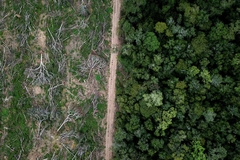Nestlé unveils global cocoa diversity map to strengthen supply stability amid climate shocks
Key takeaways
- Nestlé and partners map 95% of global cocoa diversity, creating a 96-variety core collection to fast-track climate-resilient and high-quality cocoa breeding.
- The genomic study analyzed over 300 varieties using deep sequencing to address supply-chain vulnerability from relying on limited commercial cocoa genetics.
- Nestlé pairs this research with sustainability efforts, including cocoa-pod upcycling and farmer support through the Nestlé Cocoa Plan.
Nestlé has mapped cocoa varieties representing over 95% of the crop’s global genetic diversity in partnership with its research partners. The teams have developed a “core collection” that allows faster identification of cocoa varieties with traits like climate resilience, disease tolerance, higher yield, and sensory quality to enhance cocoa resilience amid climate challenges.
These efforts come as the F&B industry reels from the impact of extreme weather disrupting cocoa supply. Chocolate manufacturers are exploring cocoa substitutes that reduce dependency on the popular confectionery ingredient. Farmer collaborations and retail tactics are among the other coping measures emerging to advance chocolate’s next chapter.
A core collection is a small, carefully chosen set of plant varieties that captures the full genetic diversity of a species, allowing experts to study it without maintaining thousands of trees.
Nestlé’s core collection consists of 96 cocoa varieties and offers a “crucial foundation” for building a more resilient supply chain as climate change, pests, and diseases impact cocoa yields and farmer livelihoods, says Nestlé.
“Assembling the world’s genetic diversity of cocoa into a well-curated collection, or a ‘Noah’s Ark’ of cocoa diversity, not only makes sense from a conservation point of view,” says Jeroen Dijkman, head of the Nestlé Institute of Agricultural Sciences.

“It will also allow us to uncover key traits that can be used in traditional breeding programs to safeguard the future of cocoa.”
Mapping cocoa
The research, published in BMC Genomics, was a collaboration between Nestlé Research, The Pennsylvania State University (Penn State), the Tropical Agricultural Research and Higher Education Center (CATIE), and Fox Consultancy. Penn State generated several of the high-quality genome sequences through its Molecular Biology of Cacao research program.
CATIE, based in Costa Rica, provided access to what it calls “one of the world’s largest living cacao collections,” which includes several genotypes represented in this core collection.
Patrick Descombes, senior expert in Genomics at the Nestlé Institute of Food Safety and Analytical Sciences, explains that despite cocoa being a key ingredient in various products (especially chocolate), “only a small percentage of global cocoa diversity is currently used in commercial production.” This makes its supply chain more vulnerable to a fast-changing world.
“We leveraged cutting-edge genomic techniques, including deep sequencing of cocoa tree genomes, advanced data analysis, and bioinformatics, to explore genetic similarities and differences across over 300 cocoa varieties and establish this core collection.”
Advancing cocoa sustainability
Nestlé is also exploring innovative cocoa post-harvest solutions, such as a patented technique that upcycles underutilized parts of the cocoa pods to produce cocoa flakes, for extracting more value from the fruit.
Earlier this year, the company developed a method that utilizes up to 30% more of the cocoa fruit to produce chocolate, aiming to reduce waste and increase value for cocoa farmers.
The company also supports sustainable cocoa farming by partnering with farmers and organizations to improve agricultural practices, enhance farmer livelihoods, and ensure responsible sourcing through its sourcing program, Nestlé Cocoa Plan.











